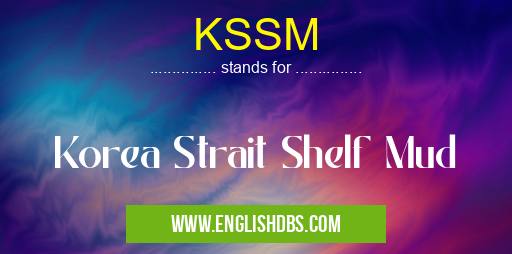What does KSSM mean in UNCLASSIFIED
KSSM stands for Korea Strait Shelf Mud, which refers to a specific type of marine sediment found in the Korea Strait, a narrow body of water located between the Korean Peninsula and the Japanese island of Tsushima.

KSSM meaning in Unclassified in Miscellaneous
KSSM mostly used in an acronym Unclassified in Category Miscellaneous that means Korea Strait Shelf Mud
Shorthand: KSSM,
Full Form: Korea Strait Shelf Mud
For more information of "Korea Strait Shelf Mud", see the section below.
What is KSSM?
KSSM is a unique type of mud that is composed of fine-grained particles, primarily consisting of clay minerals and organic matter. It is characterized by its high water content, low permeability, and high compressibility. KSSM is typically found in depths ranging from 50 to 150 meters within the Korea Strait.
Properties and Characteristics of KSSM
- High water content: KSSM typically contains a high percentage of water, ranging from 60% to 80%, which contributes to its soft and cohesive nature.
- Low permeability: KSSM has a low permeability, meaning it resists the flow of water and other fluids through its pores. This characteristic is attributed to its fine-grained composition.
- High compressibility: KSSM is highly compressible, which means it can undergo significant deformation under load. This property makes it susceptible to subsidence and other geotechnical challenges.
- Organic matter content: KSSM contains a significant amount of organic matter, which contributes to its dark gray to black color and its characteristic odor.
Formation and Deposition of KSSM
KSSM is formed through the deposition of fine-grained sediments in the Korea Strait. These sediments are derived from a combination of sources, including:
- Terrestrial erosion: Sediment from rivers and streams flowing into the Korea Strait contributes to the formation of KSSM.
- Marine erosion: Wave action and currents erode coastal areas, releasing sediment into the water column.
- Biological activity: Marine organisms, such as microorganisms and shellfish, contribute to the production of organic matter and biogenic sediment in the Korea Strait.
Importance of KSSM
KSSM is an important marine sediment that has various implications for:
- Geotechnical engineering: The compressibility and low permeability of KSSM pose challenges for construction projects in the Korea Strait.
- Marine ecology: KSSM provides a suitable habitat for various marine organisms and contributes to the food chain.
- Environmental monitoring: The organic matter content of KSSM can be used as an indicator of pollution and environmental changes in the Korea Strait.
Essential Questions and Answers on Korea Strait Shelf Mud in "MISCELLANEOUS»UNFILED"
What is the Korea Strait Shelf Mud (KSSM)?
The Korea Strait Shelf Mud (KSSM) is a large, fan-shaped mud deposit in the Yellow Sea, located between South Korea and China. It is composed of fine-grained sediments that have been transported and deposited by the Yellow River over thousands of years. KSSM is known for its unique properties, including its high clay content, low density, and high porosity.
How was the KSSM formed?
The KSSM was formed by the erosion and transport of sediments by the Yellow River. The sediment-laden waters of the Yellow River flow into the Yellow Sea, where they are deposited on the seafloor. Over time, the weight of the sediment compacts the lower layers, forming a dense mud deposit. The upper layers of the deposit remain relatively loose and porous due to their high clay content.
What are the characteristics of KSSM?
KSSM is characterized by its fine-grained composition, high clay content (over 50%), low density (around 1.5 g/cm3), and high porosity (over 50%). The mud is typically gray or brown in color and has a soft, slightly sticky texture. KSSM is also known for its high water content, which can reach up to 80%.
What are the uses of KSSM?
KSSM is used in a variety of applications, including:
- Construction: KSSM is used as a lightweight fill material in construction projects, due to its low density and high porosity.
- Agriculture: KSSM is used as a soil amendment in agriculture, due to its high clay content and ability to retain water and nutrients.
- Environmental remediation: KSSM is used in environmental remediation projects to absorb pollutants and heavy metals from contaminated soil and water.
- Geotechnical engineering: KSSM is used in geotechnical engineering applications, such as the construction of dams and levees, due to its high compressibility and low permeability.
Is KSSM safe for use?
KSSM is generally considered safe for use in most applications. However, it is important to note that KSSM can contain high levels of certain heavy metals, such as lead and arsenic. Therefore, it is important to test KSSM before using it in applications where human health or environmental safety is a concern.
Final Words: KSSM is a distinctive type of marine sediment found in the Korea Strait. Its unique properties, including high water content, low permeability, and high compressibility, make it an important factor in geotechnical engineering, marine ecology, and environmental monitoring in the region. Understanding the characteristics and formation of KSSM is essential for addressing challenges and managing resources in the Korea Strait.
